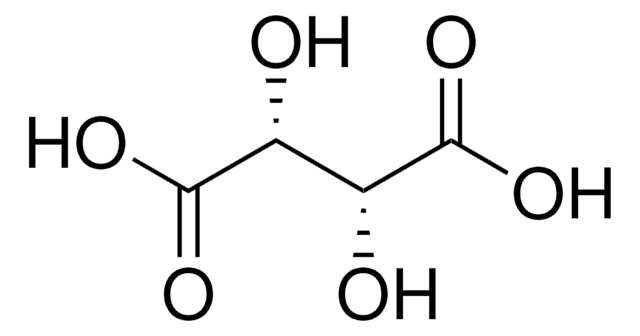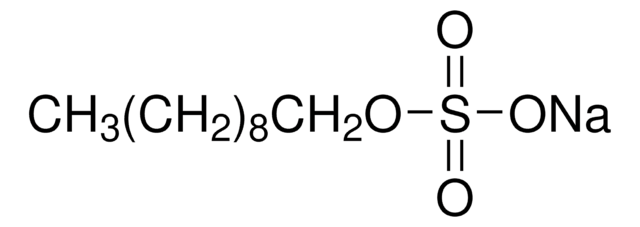71726
Natriumdodecylsulfat
suitable for ion pair chromatography, LiChropur™, ≥99.0%
Synonym(e):
Dodecylsulfat Natriumsalz, Laurylsulfat Natriumsalz, Natriumlaurylsulfat, SDS
About This Item
Empfohlene Produkte
Qualitätsniveau
Beschreibung
anionic
62
Assay
≥99.0% (GC)
≥99.0%
Form
rod
Qualität
LiChropur™
Mol-Gew.
288.38 g/mol
Methode(n)
ion pair chromatography: suitable
mp (Schmelzpunkt)
204-207 °C (lit.)
Löslichkeit
water: soluble
λ
10 % in H2O
UV-Absorption
λ: 210 nm Amax: 0.1
λ: 220 nm Amax: 0.06
λ: 230 nm Amax: 0.04
λ: 260 nm Amax: 0.02
λ: 500 nm Amax: 0.02
HLB
40
Eignung
corresponds to standard for RP gradient test
corresponds to standard for filter test
SMILES String
[Na+].CCCCCCCCCCCCOS([O-])(=O)=O
InChI
1S/C12H26O4S.Na/c1-2-3-4-5-6-7-8-9-10-11-12-16-17(13,14)15;/h2-12H2,1H3,(H,13,14,15);/q;+1/p-1
InChIKey
DBMJMQXJHONAFJ-UHFFFAOYSA-M
Suchen Sie nach ähnlichen Produkten? Aufrufen Leitfaden zum Produktvergleich
Allgemeine Beschreibung
Anwendung
- beim Peptid-Mapping und der Proteinanalyse durch Gelelektrophorese
- zur Verwendung bei der Entwicklung von Formulierungen und ihrer Wirkung auf die Adsorptions- und Mizellisierungsparameter
- bei der Messung von Protein-SDS-Komplexen und der SDS-Lösung in Guanidinhydrochlorid mittels Gelchromatographie
- bei der Trennung von Proteinuntereinheiten, die mit SDS dissoziiert wurden, mithilfe der Hydroxylapatit-Chromatographie.
Rechtliche Hinweise
Signalwort
Danger
Gefahreneinstufungen
Acute Tox. 4 Inhalation - Acute Tox. 4 Oral - Aquatic Chronic 3 - Eye Dam. 1 - Flam. Sol. 2 - Skin Irrit. 2 - STOT SE 3
Zielorgane
Respiratory system
Lagerklassenschlüssel
4.1B - Flammable solid hazardous materials
WGK
WGK 2
Flammpunkt (°F)
338.0 °F
Flammpunkt (°C)
170 °C
Persönliche Schutzausrüstung
Eyeshields, Faceshields, Gloves, type P3 (EN 143) respirator cartridges
Hier finden Sie alle aktuellen Versionen:
Besitzen Sie dieses Produkt bereits?
In der Dokumentenbibliothek finden Sie die Dokumentation zu den Produkten, die Sie kürzlich erworben haben.
Kunden haben sich ebenfalls angesehen
Unser Team von Wissenschaftlern verfügt über Erfahrung in allen Forschungsbereichen einschließlich Life Science, Materialwissenschaften, chemischer Synthese, Chromatographie, Analytik und vielen mehr..
Setzen Sie sich mit dem technischen Dienst in Verbindung.







